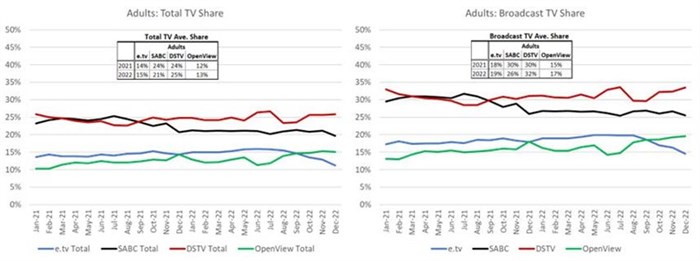
Related
Top stories






More news












Previously the industry, with the exception of broadcasters who always had access to the data, had access to broadcast TV data only. Broadcast TV includes total viewing of any content viewed on broadcast channels but excludes any viewing via streaming or other devices on a TV set.
In recent years, there has been an exponential growth in viewing content via steaming or other devices connected to a TV set.
Users can select whether they want to analyse data based on Total TV or Broadcast TV. With that in mind, there are a couple of important points to remember:
The graphs below show how the share of station groups have changed over the last two years and who commands the largest share of Total TV vs Broadcast TV. In the case of All Adults, DStv leads followed by SABC. The trends across Total TV vs Broadcast are very similar however the Station Groups percentage share decreases when measured against Total TV. We can see DStv overtaking SABC in Sep-21. We can also see OpenView has overtaken e.tv in Sep-22. For the graphs below only the major channel groups have been included.

How does the data help to inform planning and understanding changing viewer habits?
Looking at Pay vs Free to View (FTV) Adult Audiences, one can clearly see how the Station Groups share of Total vs Broadcast TV changes.
The above graphs clearly demonstrate how the relationship between broadcast channels is changing and who is gaining share and who has significant share of the Total TV vs Broadcast TV landscape.
The data and insights will change depending on the target audiences as well as the Channel mix analysed. Different time bands i.e., prime vs off peak; may well provide a different outlook as well.
The three graphs below demonstrate how the picture changes against the 3 SEM Super Groups.
The above shows that no matter the economic sector, viewing all Content on a TV set, including viewing via streaming or other devices is increasing across all audiences which will ultimately impact on campaign performance as audience viewing becomes increasingly fragmented.
Understanding the dynamics and shifts between the three major competitor TV Groups, is also enlightening. Reflecting e.tv and OpenView as a combined commercial offering, clearly shows how the group has overtaken both SABC and DSTV.
Only at SEM Super 3 level does DStv overtake eMedia.
Analysing Total TV vs Broadcast TV share data, provides insight into the exponential growth in viewing content via steaming or other devices connected to the TV set and how it impacts TV stations groups share. Currently the TAMS data does not provide details on non-broadcast content and therefore this viewing cannot be included as part of campaign planning. A key objective for 2023 for the BRC is the TAMS measurement of alternative devices used in the home to view TV content which will facilitate wholistic viewing measurement.
The Advertising Media Forum (AMF) is a collective of media agencies and individuals including media strategists, planners, buyers and consultants through whom 95% of all media expenditure in South Africa is bought. The AMF advises and represents relevant organisations and aims to create open channels of communication and encourage and support transparent policies, strategies and transactions within the industry.
For more information on the AMF, visit amf.org.za.
For comment on the industry issue covered in this editorial, please contact:
Koo Govender
AMF Chairperson
Cell: 083 272 0063
Email: moc.sigeaustned@rednevoG.ooK
OR
Karen Phelan
Board Member
Cell: 082 901 9467
Email: ten.asmoklet@nalehpk